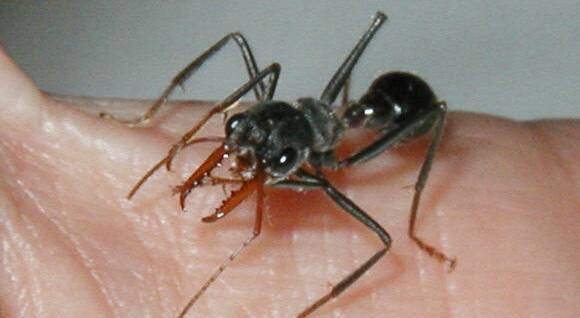
The pain from a bull ant is from the sting in its abdomen, not from its ferocious-looking pincers.
Subscribe now for unlimited access.
$0/
(min cost $0)
or signup to continue reading
The sting itself is not barbed like that of a bee.
Unfortunately for us, it can be used multiple times.
The strong pincers are used more for carrying than they are for biting.
A reader reports that he has been forced to take more notice of large ants in recent years because of a serious reaction to their stings.
He has not yet been stung by the large black bull dog ants, but has been attacked three times by the smaller, more agile and more aggressive jumper ants or jackjumpers.
A bull ant’s sting contains some of the most toxic venom in the insect world.
Many people are allergic to it, and those not allergic can have an itching spot for a few days afterwards.
The jumper ants – about 10 millimetres long and with yellow or orange pincers and legs – are the usual stinging culprits.
The larger bull dog ants can measure 25 or 26 millimetres long.
They are generally rather “slow and steady”.
However, they can certainly be active and alert when disturbed.
Most local specimens are black, but red ones occur in drier or sandier districts.
The red ones are more active.
All these bullants build mounded, camouflaged ground nests, very different from the wide gravel-clad mounds of the meat ant.
The entrances are usually hidden or small.
The true bull ants (the bulldogs and the jackjumpers) tend to wander singly after food, although they live in colonial mounds.
They defend these unhesitatingly.
Adults feed mainly on nectar, other sweet substances and fluids of insects.
They gather insects and other such prey to carry back to the nest for their larvae.
Jackjumpers are often found on or near flowering eucalypts.
These ants have few predators.
Echidnas dig into their burrows in search of the larvae, but they leave the adults.
The echidna somehow copes quite well with the inevitable numerous stings that must occur.
Other common bush ants are the sugar ant and the meat ant.
However, neither of these have the painful sting of the bull dog ants or the jackjumpers.
SURPRISING SONGSTER
A surprise at Lake Wendouree last weekend was a reed warbler in full voice.
The reed warbler is a migrant, usually leaving here in February or March.
A singing bird in April has not been known before.

